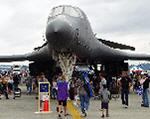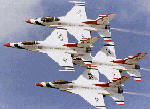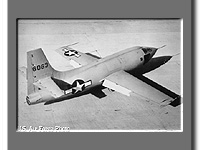
|
Description
| Manufacturer: | Bell |
| |
| Base model: | S-1 | ||
| Designation: | XS-1 | ||
| Designation System: | U.S. Air Force | ||
| Designation Period: | 1946-1947 | ||
| Basic role: | Supersonic Research | ||
| Status: | Experimental | ||
| Crew: | Pilot | ||
| First Flew: | 1946/12/09 | ||
| See Also: | X-1 | ||
Specifications
| Length: | 30.9' | 9.4 m | |
| Height: | 10.85' | 3.3 m | |
| Wingspan: | 28' | 8.5 m | |
| Wingarea: | 130.0 sq ft | 12.0 sq m | |
| Empty Weight: | 7,000 lb | 3,174 kg | |
| Gross Weight: | 12,225 lb | 5,555 kg | |
| Max Weight: | 12,250 lb | 5,557 kg | |
Propulsion
| No. of Engines: | 1 | ||
| Powerplant: | Reaction Motors XLR11-RM3 rocket engine | ||
| Thrust (each): | 6,000 lb | 2,721 kg | |
Performance
| Max Speed: | 957 mph | 1,541 km/h | 832 kt |
| Ceiling: | 71,902 ft | 21,915 m | |
History
| Date | Subject | Event |
| 1947/10/14 | The Bell X-1, flown by test pilot Captain Charles 'Chuck' Yeager, broke the sound barrier for the first time, reaching Mach 1.015 (670mph). | |
| 1948/03/26 | A Bell X-1 was flown by Capt. Charles 'Chuck' Yeager to a new altitude record of 64,0000 ft. |
Known serial numbers
Examples of this type may be found at
| Museum | City | State |
| National Air and Space Museum | Washington | Dist of Col |
| The Air Museum "Planes of Fame" | Chino | California |
X-1 on display
National Air and Space Museum | The Air Museum "Planes of Fame" |
Recent comments by our visitors
| Guy E. Franklin Deastville, AL | Bell X-1
X-1 #46-062, nicknamed "Glamorous Glennis" Type rocket plane Manufacturer Bell Aircraft Corporation Maiden flight 1946-01-19 Status Retired Primary users USAF NACA The Bell X-1, originally XS-1 was the first aircraft to exceed the speed of sound in controlled, level flight. It was the first of the so called X-planes, a series of aircraft designated for testing of new technologies and usually kept highly secret. Many believe the X-1 was heavily based on the British designed Miles M.52 jet. The Miles M.52 was strangely cancelled by the British government months away from a test flight, and all technical data regarding it was transferred to Bell. Later tests show that the Miles M.52 would have broken the sound barrier if allowed to fly. Chalmers "Slick" Goodlin was the original test pilot for the second plane in the X-1 program. He made twenty-six successful flights in both of the X-1 aircraft from September 1946 until June 1947. Bell Aircraft's contract was terminated and was taken over by the United States Air Force. On October 14, 1947, Captain Charles "Chuck" Yeager of the Air Force flew aircraft #46-062, which he had named 'Glamorous Glennis', after his wife. The rocket-powered aircraft was launched from the belly of a specially modified B-29 and glided to a landing on a runway. Aircraft #46-062 is the model currently on display in the main atrium of the National Air and Space Museum in Washington, DC, on the same side as the Spirit of St. Louis and SpaceShipOne. The German pilot Hans Guido Mutke claimed to be the first person to break the sound barrier, on April 9, 1945 in a Messerschmitt Me 262, but this claim is disputed. The mysterious 702 mph Me-163B by Dittmar flight is wrapped in mystery and has no Mach number associated with it. Many also contend that George Welch broke the barrier on October 1, 1947 in his XP-86 Sabre during a dive, just two weeks before the X-1. Full confirmation of Welch's achievement is not available, although it is very likely that he exceeded Mach 1 more than once sometime in the October - November, 1947 period, and perhaps as early as October 1. Contents [hide] 1 History 2 Chuck Yeager quotes 3 Aircraft serial numbers 4 Specifications (X-1) 4.1 General characteristics 4.2 Performance 5 See also 6 References 7 External links 8 See also [edit] History X-1 at the SmithsonianBeginning in 1946, two XS-1 (for "Experimental, Supersonic", later X-1) experimental research aircraft conducted pioneering tests at Muroc Army Air Field (now Edwards Air Force Base) in California to obtain flight data on conditions in the transonic speed range. These early tests culminated in the first piloted flight faster than Mach 1.0, the speed of sound. XS-1 flight number 50 is the first one where the X-1 recorded supersonic flight, at Mach 1.06 peak speed; however, Yeager and many other personnel record the possibility that Flight #49 (also with Yeager piloting), which reached a top recorded speed of Mach 0.997, may have in fact passed the Sound Barrier. (The measurements were not accurate to three significant figures and no sonic boom is recorded for that flight.) XLR-11 rocket engineThe XS-1 was the first high-speed aircraft built purely for aviation research purposes. The model was never intended for production. She was designed largely in accordance with specifications provided by the National Advisory Committee for Aeronautics (NACA) (now NASA), paid for by the Army Air Forces, and built by Bell Aircraft Inc. The XS-1 #2 (serial number 46-063) was flight tested by the NACA to provide design data for later production high-performance aircraft. The research techniques used in the X-1 program became the pattern for all subsequent X-craft projects. The NACA X-1 procedures and personnel also helped lay the foundation of America's space program in the 1960s. The X-1 project defined and solidified the post-war cooperative union between U.S. military needs, industrial capabilities, and research facilities. The flight data collected by the NACA in the X-1 tests then provided a basis for American aviation supremacy in the latter half of the 20th century. As a result of the X-1's initial supersonic flight, the National Aviation Association voted its 1948 Collier Trophy to be shared by the three main participants in the program. Honored at the White House by President Truman were Larry Bell for Bell Aircraft, Captain Yeager for piloting the flights, and John Stack of NACA for the NACA contributions. Years later, Yeager reported that his father, a staunch Republican, refused to shake hands with President Truman (a Democrat). [edit] Chuck Yeager quotes "During dogfights you would go into high-speed dives, or as fast as you could get the airplane going straight down from, you know, 36 or 37 thousand feet, and when this happened a shock-wave formed on the thickest part of the wing, and behind the shock-wave you had turbulent air, and it was just a nuisance if you were trying to track some guy to shoot him down..." "...priorities were, get the airplane above mach one as soon as you can, and don't kill yourself, and don't embarrass the Air Force." "Are you ready?" "Hell, yes. Let's get it over with." (radio transcript) "I was lucky to live through the thing, lucky to be involved. I was at the right place at the right time at the right age, and I had the right... capability to take advantage of it." [edit] Aircraft serial numbers [edit] Specifications (X-1) [edit] General characteristics Crew: 1 Length: 30 ft 11 in (9.4 m) Wingspan: 28 ft 0 in (8.5 m) Height: 10 ft 10 in (3.3 m) Wing area: 130 ft² (12 m²) Empty: 7,000 lb (3,175 kg) Loaded: 12,225 lb (5,545 kg) Maximum takeoff: 12,250 lb (5,557 kg) Powerplant: Reaction Motors XLR-11-RM3 rocket engine, 6,000 lbf (26.7 kN) thrust [edit] Performance Maximum speed: 957 mph (1,541 km·h-1) Range: 5 minutes powered endurance Service ceiling: 71,900 ft (21,900 m) Wing loading: 94 lb/ft² (463 kg·m-1) Thrust/weight: 0.49 09/29/2006 @ 09:46 [ref: 14328] |
| Guy E. Franklin Deastville, AL | Bell X-1
From Wikipedia, the free encyclopedia Jump to: navigation, search For the article about the Irish band, see Bell X1. Bell X-1 X-1 #46-062, nicknamed "Glamorous Glennis" Type rocket plane Manufacturer Bell Aircraft Corporation Maiden flight 1946-01-19 Status Retired Primary users USAF NACA The Bell X-1, originally XS-1 was the first aircraft to exceed the speed of sound in controlled, level flight. It was the first of the so called X-planes, a series of aircraft designated for testing of new technologies and usually kept highly secret. Many believe the X-1 was heavily based on the British designed Miles M.52 jet. The Miles M.52 was strangely cancelled by the British government months away from a test flight, and all technical data regarding it was transferred to Bell. Later tests show that the Miles M.52 would have broken the sound barrier if allowed to fly. Chalmers "Slick" Goodlin was the original test pilot for the second plane in the X-1 program. He made twenty-six successful flights in both of the X-1 aircraft from September 1946 until June 1947. Bell Aircraft's contract was terminated and was taken over by the United States Air Force. On October 14, 1947, Captain Charles "Chuck" Yeager of the Air Force flew aircraft #46-062, which he had named 'Glamorous Glennis', after his wife. The rocket-powered aircraft was launched from the belly of a specially modified B-29 and glided to a landing on a runway. Aircraft #46-062 is the model currently on display in the main atrium of the National Air and Space Museum in Washington, DC, on the same side as the Spirit of St. Louis and SpaceShipOne. The German pilot Hans Guido Mutke claimed to be the first person to break the sound barrier, on April 9, 1945 in a Messerschmitt Me 262, but this claim is disputed. The mysterious 702 mph Me-163B by Dittmar flight is wrapped in mystery and has no Mach number associated with it. Many also contend that George Welch broke the barrier on October 1, 1947 in his XP-86 Sabre during a dive, just two weeks before the X-1. Full confirmation of Welch's achievement is not available, although it is very likely that he exceeded Mach 1 more than once sometime in the October - November, 1947 period, and perhaps as early as October 1. Contents [hide] 1 History 2 Chuck Yeager quotes 3 Aircraft serial numbers 4 Specifications (X-1) 4.1 General characteristics 4.2 Performance 5 See also 6 References 7 External links 8 See also [edit] History X-1 at the SmithsonianBeginning in 1946, two XS-1 (for "Experimental, Supersonic", later X-1) experimental research aircraft conducted pioneering tests at Muroc Army Air Field (now Edwards Air Force Base) in California to obtain flight data on conditions in the transonic speed range. These early tests culminated in the first piloted flight faster than Mach 1.0, the speed of sound. XS-1 flight number 50 is the first one where the X-1 recorded supersonic flight, at Mach 1.06 peak speed; however, Yeager and many other personnel record the possibility that Flight #49 (also with Yeager piloting), which reached a top recorded speed of Mach 0.997, may have in fact passed the Sound Barrier. (The measurements were not accurate to three significant figures and no sonic boom is recorded for that flight.) XLR-11 rocket engineThe XS-1 was the first high-speed aircraft built purely for aviation research purposes. The model was never intended for production. She was designed largely in accordance with specifications provided by the National Advisory Committee for Aeronautics (NACA) (now NASA), paid for by the Army Air Forces, and built by Bell Aircraft Inc. The XS-1 #2 (serial number 46-063) was flight tested by the NACA to provide design data for later production high-performance aircraft. The research techniques used in the X-1 program became the pattern for all subsequent X-craft projects. The NACA X-1 procedures and personnel also helped lay the foundation of America's space program in the 1960s. The X-1 project defined and solidified the post-war cooperative union between U.S. military needs, industrial capabilities, and research facilities. The flight data collected by the NACA in the X-1 tests then provided a basis for American aviation supremacy in the latter half of the 20th century. As a result of the X-1's initial supersonic flight, the National Aviation Association voted its 1948 Collier Trophy to be shared by the three main participants in the program. Honored at the White House by President Truman were Larry Bell for Bell Aircraft, Captain Yeager for piloting the flights, and John Stack of NACA for the NACA contributions. Years later, Yeager reported that his father, a staunch Republican, refused to shake hands with President Truman (a Democrat). [edit] Chuck Yeager quotes "During dogfights you would go into high-speed dives, or as fast as you could get the airplane going straight down from, you know, 36 or 37 thousand feet, and when this happened a shock-wave formed on the thickest part of the wing, and behind the shock-wave you had turbulent air, and it was just a nuisance if you were trying to track some guy to shoot him down..." "...priorities were, get the airplane above mach one as soon as you can, and don't kill yourself, and don't embarrass the Air Force." "Are you ready?" "Hell, yes. Let's get it over with." (radio transcript) "I was lucky to live through the thing, lucky to be involved. I was at the right place at the right time at the right age, and I had the right... capability to take advantage of it." [edit] Aircraft serial numbers [edit] Specifications (X-1) [edit] General characteristics Crew: 1 Length: 30 ft 11 in (9.4 m) Wingspan: 28 ft 0 in (8.5 m) Height: 10 ft 10 in (3.3 m) Wing area: 130 ft² (12 m²) Empty: 7,000 lb (3,175 kg) Loaded: 12,225 lb (5,545 kg) Maximum takeoff: 12,250 lb (5,557 kg) Powerplant: Reaction Motors XLR-11-RM3 rocket engine, 6,000 lbf (26.7 kN) thrust [edit] Performance Maximum speed: 957 mph (1,541 km·h-1) Range: 5 minutes powered endurance Service ceiling: 71,900 ft (21,900 m) Wing loading: 94 lb/ft² (463 kg·m-1) Thrust/weight: 0.49 09/29/2006 @ 09:45 [ref: 14327] |
| Guy E. Franklin Deastville, AL | Class: Manned. Type: Rocketplane. Destination: Suborbital. Nation: USA. Manufacturer: Bell.
Also known as the X-1. This rocket plane was the first aircraft to break the sound barrier, and the first in a line of X- aircraft leading to the space shuttle. Due to the press of war work, Bell Aircraft was the only company that would take on the project in 1944. German swept-wing research being unknown, the configuration developed was a thin, straight-winged aircraft with a bullet-shaped fuselage. The XS-1 began flight test in 1946 and Chuck Yeager flew it through the sound barrier on October 14, 1947. Main Engine: XLR-11. Main Engine Propellants: Lox/Alcohol. 09/29/2006 @ 09:44 [ref: 14326] |
Recent photos uploaded by our visitors








